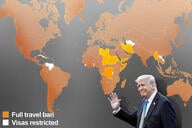You have /5 articles left.
Sign up for a free account or log in.
More graduate applications from outside the United States -- especially from China – are pouring into U.S. universities, according to a new study by the Council of Graduate Schools.
Nathan Bell, the Council’s director for research and policy analysis, said the 9 total percent total growth in applications indicates a continued interest in American graduate programs. This year marked the seventh year-over-year increase in applications.
“Nine percent growth is pretty amazing,” he said. “For the last three years, it’s been very, very strong.”
Those numbers, which measure the number of applications submitted and not the number of prospective or accepted students, mirrored the overall trends from a year ago. This year’s 9 percent growth rate is just off the 2011 rate of 11 percent, while the 18 percent growth in applications from Chinese students compares to 21 percent growth last year.
The council collected data on more than 500,000 applications from universities that award a combined 60 percent of the total number of graduate degrees granted to foreign students. For the first time, the study tracked year-to-year trends in more individual regions and countries. Researchers used preliminary data for this year, which they will update once colleges collect and calculate late-coming applications.
While interest grew in China, the leading supplier of international grad students to the America, numbers seemed to flatline in other Asian countries known for sending thousands of graduate students to the U.S.
Applications from South Korea (-1 percent), Taiwan (-2 percent) and India (+2 percent) remained basically stagnant. And after at least three years of double-digit increases, Middle Eastern application growth slowed to a 6 percent uptick (though some of that might be due to the study’s reclassification of Turkey and Cyprus as European nations).
India is the second-leading supplier of graduate students to the United States, though there was a 12 percent drop in applications from the subcontinent three years ago. There has been a bit of a rebound since then -- with year-to-year increases of 1, 8 and 2 percent -- but Bell said numbers of Indian graduate students appeared to have flatlined for the time being.
At Eastern Illinois University’s Graduate School, Dean Robert Augustine has seen similar trends play out. His applications increased again this year, as did the university’s cohort of foreign graduate students. There are 92 international graduate students now on campus, up from 77 in 2009.
Having those students enriches the classroom experience for everyone, he said, especially in disciplines such as economics where a foreign viewpoint might add diversity to a discussion.
“We need international graduate students in key programs to ensure that the conversation includes the global conversation,” said Augustine, who is also the incoming board chair of the Council of Graduate Schools.
But while Eastern Illinois’s overall application trends are similar to the national picture, its international student body is not. More than half of the institution’s foreign graduate students are from India. The university also enrolls seven Chinese grad students, and a smattering of no more than four students from more than 20 other countries.
While Augustine is confident Eastern Illinois has enough diversity in the countries represented on campus, Bell said there’s a risk of colleges becoming overdependent on one or two home countries. “You don’t know what’s going to happen politically with a country or economically with a country,” he said. “It could really affect the amount of students coming from one year to the next.”
But over all, Bell said, this year’s study is good news for American graduate schools. Despite a recession and budget cuts – to say nothing of the 9/11 attacks that slashed foreign enrollment – U.S. colleges are marketing themselves well abroad and are seen as a desirable location.
“We’re the country where students want to come,” he said. “They recognize the value of the program.”
Among the study’s other findings:
- Applications from America’s two neighbors were up considerably, with a 17 percent rise in Mexico and a 9 percent jump in Canada.
- Brazil, South America’s leading supplier of graduate students to the U.S., saw a 14 percent increase in applications over last year.
- Applications from Africa dropped 5 percent. Bell said it was too early to tell whether unrest in Egypt and other parts of North Africa played a significant role.
- Seventeen percent of foreign applications were to education programs, compared with 8 percent two years ago.
Year-to-Year Percentage Change in Graduate Applications
Data from the Council of Graduate Schools. Data for Taiwan, Canada, Mexico, Brazil, Africa and Europe were not tracked until this year. Turkey and Cyprus were included as part of the Middle East until this year, when they were switched to Europe. Data from this year are preliminary. Countries and regions are listed by the council in no particular order.
|
Country or Region |
2008-9 | 2009-10 | 2010-11 | 2011-12 |
| China | 14% | 20% | 21% | 18% |
| India | -12% | 1% | 8% | 2% |
| South Korea | -9% | 0% | 2% | -1% |
| Taiwan | -2% | |||
| Canada | 9% | |||
| Mexico | 17% | |||
| Brazil | 14% | |||
| Africa | -5% | |||
| Europe | 7% | |||
| Middle East | 22% | 20% | 16% | 6% |




